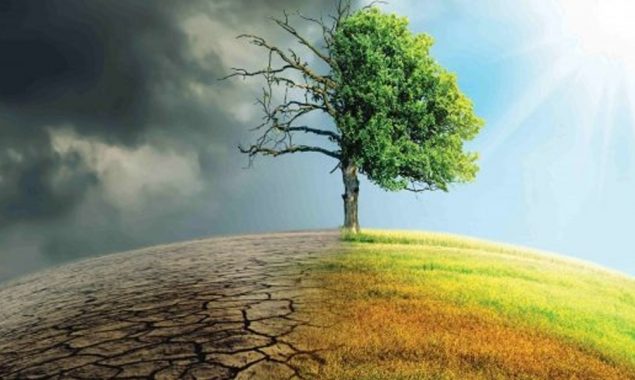
Photo: File
KARACHI: With the latest edition of the United Nations Climate Change Conference (COP26), being the subject of global chatter, and discussions around Greenhouse Gas Emissions, a warming planet and countries’ policies to tackle the adverse impacts of climate change taking place at every forum, it is important to consider what all of this means for Pakistan.
The country, which happens to be one of the lowest emitters, is widely considered to be one that will have to face a disproportionately high amount of climate related catastrophes if the current warming trends continue. This is because Pakistan is already at risk of multiple natural threats due to its geographical diversity and its varied climate. At the moment, the nation faces recurring heatwaves, droughts, floods, landslides, storms and cyclones, which are only expected to increase over the next few years.

Graphic source: Reliefweb.in and climatelinks.org
These natural calamities already disrupt the livelihoods of locals and the economy of the nation. In Pakistan’s future, the science points towards increased temperatures far above global averages. The World Bank Country Risk Profile puts Pakistan among the top risk-prone countries when it comes to climate change. But what exactly does that mean?
Read more: PM Imran Khan underscores need for US, Pakistan’s sharing of ‘ideas’ on climate change
Climate
The current trend towards warming temperatures has accelerated particularly in the last five years, and is strongly biased towards the winter and post-monsoon months. The warming is likely to be worst in the Southern regions, with Punjab and Balochistan set to experience winter warming, while Sindh is likely to face increasing heat spells throughout the year. Contrastingly, Khyber Pakhtunkhwa will not face similar warming. Rainfall in Pakistan is a varied phenomenon. However, the key trend regarding precipitation across the country has been the steady increase in the number of heavy rainfall events since the 1960s. In fact the country experienced its heaviest one-day rains in 2010.
Heatwaves
Pakistan regularly experiences some of the highest maximum temperatures in the world, with an average monthly maximum of around 27°C and an average June maximum of 36°C, while many regions experience temperatures of 38°C and above on an annual basis. A large section of the population is exposed to risks of heatstroke, with over 65,000 people being hospitalised due to stroke during the 2015 heatwave in Sindh, of which 1,200 died. An estimated 126 heatwaves have been experienced in Pakistan between 1997 and 2015, coming down to an average of seven heatwaves per year – a trend that is increasing. According to a WB report, scientists have identified Karachi and Lahore as the most adversely affected cities when it comes to extreme heat and the high mortality associated with it. Depending on the emission pathways, the probability of heatwaves could increase by three per cent to 23 per cent.
Drought
Two primary types of drought may affect Pakistan; meteorological, usually associated with a precipitation deficit; and hydrological, usually associated with a deficit in surface and subsurface water flow, potentially originating in the region’s larger river basins. At present Pakistan faces an annual median probability of severe meteorological drought of around 3 per cent according to the Standardised Precipitation Evaporation Index (SPEI). No matter what happens with the amount of global carbon emissions, whether they increase or decrease, with the damage already done to the climate Pakistan faces a risk of very high increases in meteorological drought.
Read more: Tuvalu’s foreign minister addresses delegates at COP26 from the sea
Floods
According to the World Resources Institute Global Flood Analyzer, AQUEDUCT, as of 2010 the population annually affected by flooding in Pakistan is estimated at 714,000 people and the expected annual impact to the country’s Gross Domestic Product (GDP) is $1.7 billion. These are a consequence of increased climate change and development. Both these factors are likely to increase, and in turn increase these figures. By 2030, climate change alone is expected to increase the annually affected population by 1.5 million people, and the impact on GDP by $5.8 billion.
Depleting Resources
All these factors will adversely impact the natural resources available to the citizens of Pakistan and in turn damage their livelihoods and homes.
Water shortages
While increases in the severity of extreme events of both flood and drought seem likely, there is some uncertainty regarding the long-term outlook for water resources in Pakistan. Uncertainty surrounds projections of change in annual rainfall, some shifts in seasonality seem likely. In the context of Pakistan’s heavy reliance on the Indus Basin for its water resource, the uncertainty around future glacial change is significant. According to the United Nations Development Programme, while in the short-term the climate change impact on water resources in Pakistan may be of lesser significance in comparison with the issues presented by growing human demand for water and other issues, including the poor efficiency of Pakistan’s irrigation and water storage systems, the long-term temperature rise will result in glacial loss. This will create reductions in the runoff which feeds the Indus River, as well as changes to its seasonal profile.
Sea-levels
Pakistan’s coastline holds considerable vulnerability to sea-level rise and its associated impacts. Meteorologists suggest that without adaptation around one million people will face annual coastal flooding between 2070–2100. The largest area of vulnerability is the Indus Delta, around 4,750 kilometres of which sits below two metres above sea-level. It is estimated that around one million people live in the Delta. Meanwhile, saline intrusion continues to be a major challenge in the coastal zone, degrading land quality and agricultural yields. These issues are likely to intensify, affecting many marginal and deprived communities.
Read more: Shahbaz Gill blames previous govts for pollution in Sahiwal
Land and Soil
There is significant potential for climate change to drive an increase in the land categorised as hyper-arid (the driest category) under high emissions pathways. This phenomenon has already been documented in some regions, as droughts become more frequent in arid and semi-arid areas. Potential impacts of the expansion of drylands and desertification include the sedimentation of reservoirs, generation of dust storms, and loss of biodiversity.
With all this occurring what is worrisome is that the COP26, and other larger climate forums have failed to properly address the concerns of the Global South, despite the fact that this part of the world is at risk of massive climate catastrophes.
Catch all the Pakistan News, Breaking News Event and Latest News Updates on The BOL News
Download The BOL News App to get the Daily News Update & Follow us on Google News.




